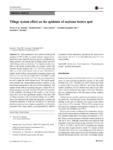Use este identificador para citar ou linkar para este item:
http://www.alice.cnptia.embrapa.br/alice/handle/doc/1029088Registro completo de metadados
| Campo DC | Valor | Idioma |
|---|---|---|
| dc.contributor.author | ALMEIDA, A. M. R. | pt_BR |
| dc.contributor.author | HAU, B. | pt_BR |
| dc.contributor.author | AMORIM, L. | pt_BR |
| dc.contributor.author | BERGAMIN FILHO, A. | pt_BR |
| dc.contributor.author | MARIANO, J. C. | pt_BR |
| dc.date.accessioned | 2015-11-19T11:11:11Z | pt_BR |
| dc.date.available | 2015-11-19T11:11:11Z | pt_BR |
| dc.date.created | 2015-11-19 | pt_BR |
| dc.date.issued | 2015 | pt_BR |
| dc.identifier.citation | Tropical Plant Pathology, v. 40, Oct. 2015. | pt_BR |
| dc.identifier.issn | 1983-2052 | pt_BR |
| dc.identifier.uri | http://www.alice.cnptia.embrapa.br/alice/handle/doc/1029088 | pt_BR |
| dc.description | Six field experiments were carried out during the summers of 1997 to 2003 to evaluate disease progress of soybean brown spot caused by Septoria glycines considering two tillage systems, conventional and no-tillage (wheat was cultivated during winter in all plots). Two logistic models were fitted to the disease progress data: (i) a logistic model with constant disease progress rate r [y=1/(1+(1/y0-1)exp(-rt)), where y0 is the initial disease level at time t=0] and (ii) a logistic model with an exponentially increasing progress rate r(t)=r0 ebt [y=1/(1+(1/y0-1) exp(r0/b(1-ebt))), where r0 is the initial progress rate at time t=0, b the rate increasing parameter, and y0 again the initial disease level]. The logistic model with constant rate underestimated disease incidence on the first disease assessment in nine out of twelve epidemics. The logistic model with an increasing rate gave a better fit to all disease progress curves (R2 between 0.90 and 0.99; no pattern in the residuals). According to this model, y0 was in most cases (four out of six) significantly smaller in the plots with no-tillage compared with conventional tillage, but no differences were detected in the initial rate parameter r0 and the rate increasing parameter b (with one exception). It is proposed that these results are due to higher susceptibility of old leaflets compared with young leaflets, as demonstrated by artificial inoculation: In four laboratory experiments the mean brown spot severity was 16.7 % on old leaflets but only 3.9 % on young leaflets. | pt_BR |
| dc.language.iso | eng | eng |
| dc.rights | openAccess | eng |
| dc.title | Tillage system effect on the epidemic of soybean brown spot. | pt_BR |
| dc.type | Artigo de periódico | pt_BR |
| dc.date.updated | 2017-06-21T11:11:11Z | pt_BR |
| dc.subject.thesagro | Soja | pt_BR |
| dc.subject.thesagro | Doença de planta | pt_BR |
| dc.subject.thesagro | Fungo | pt_BR |
| dc.subject.nalthesaurus | Soybeans | pt_BR |
| dc.subject.nalthesaurus | Fungal brown spot | pt_BR |
| dc.subject.nalthesaurus | Fungal diseases of plants | pt_BR |
| riaa.ainfo.id | 1029088 | pt_BR |
| riaa.ainfo.lastupdate | 2017-06-21 | pt_BR |
| dc.identifier.doi | 10.1007/s40858-015-0052-6 | pt_BR |
| dc.contributor.institution | ALVARO MANUEL RODRIGUES ALMEIDA, CNPSO; BERNHARD HAU, Leibniz University Hannover; LILIAN AMORIM, ESALQ; ARMANDO BERGAMIN FILHO, ESALQ; JOAQUIM C. MARIANO, COAMO. | pt_BR |
| Aparece nas coleções: | Artigo em periódico indexado (CNPSO)  | |
Arquivos associados a este item:
| Arquivo | Descrição | Tamanho | Formato | |
|---|---|---|---|---|
| tillagesystemeffect....pdf | 519,98 kB | Adobe PDF |  Visualizar/Abrir |









